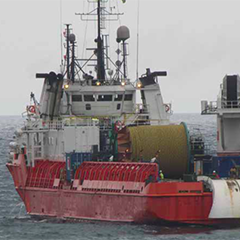Words: Paul Goodwin, Global Maritime, Pablo Ruiz-Minguela, TECNALIA, José Luis Aguiriano, OCEANTEC
For all the growth in solar and wind energy over the past few years, one often over-looked and untested renewable source is that of wave energy. Yet, wave energy is generally considered to be one of the most concentrated renewable energy sources today and one that is also complementary to solar and wind with the potential to help facilitate the practical introduction of more renewables into the European energy grid.
The different elements of the mooring system deployed at BiMEP this summer. Image courtesy of TECNALIA
Wave energy – opportunities and challenges
The World Energy Council estimates that approximately 2 terawatts (2 million megawatts) – about double current world electricity production – could be produced from the oceans via wave power. The European Union also forecasts that wave energy has the potential to supply some 10% of European electricity needs – about half of today’s renewables total.
Yet, despite its attractiveness, potential obstacles remain. Wave energy costs remain high compared to conventional forms of energy and there have been limited open-sea deployments to date. The complexities behind harnessing wave power have also led to a variety of designs and technologies with little consensus as to the optimal approach.
There is therefore an urgent need to share data and experience so as to avoid repeating earlier engineering mistakes and to de-risk wave energy technologies to attract further private sector investment, ensure the transition from R&D to commercial operation, and bring down the greatest barrier to wave energy deployment today – cost. It’s against this background that the European Union’s OPERA project was born.






























